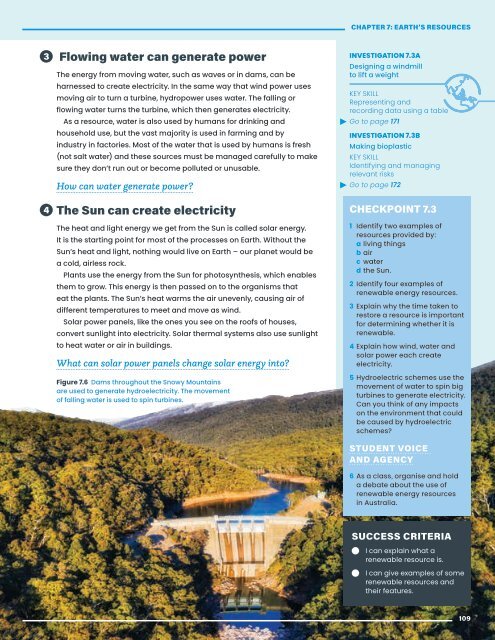Good Science Victorian Curriculum Year 7
Digital sample of Matilda's newest publication, Good Science Victorian Curriculum Year, authored by Emma Craven and Aaron Elias. For more information visit www.matildaeducation.com.au or email Katrina Tucker, katrinatucker@matildaed.com.au
Digital sample of Matilda's newest publication, Good Science Victorian Curriculum Year, authored by Emma Craven and Aaron Elias. For more information visit www.matildaeducation.com.au or email Katrina Tucker, katrinatucker@matildaed.com.au
You also want an ePaper? Increase the reach of your titles
YUMPU automatically turns print PDFs into web optimized ePapers that Google loves.
CHAPTER 7: EARTH’S RESOURCES<br />
3<br />
4<br />
Flowing water can generate power<br />
The energy from moving water, such as waves or in dams, can be<br />
harnessed to create electricity. In the same way that wind power uses<br />
moving air to turn a turbine, hydropower uses water. The falling or<br />
flowing water turns the turbine, which then generates electricity.<br />
As a resource, water is also used by humans for drinking and<br />
household use, but the vast majority is used in farming and by<br />
industry in factories. Most of the water that is used by humans is fresh<br />
(not salt water) and these sources must be managed carefully to make<br />
sure they don’t run out or become polluted or unusable.<br />
How can water generate power?<br />
The Sun can create electricity<br />
The heat and light energy we get from the Sun is called solar energy.<br />
It is the starting point for most of the processes on Earth. Without the<br />
Sun’s heat and light, nothing would live on Earth – our planet would be<br />
a cold, airless rock.<br />
Plants use the energy from the Sun for photosynthesis, which enables<br />
them to grow. This energy is then passed on to the organisms that<br />
eat the plants. The Sun’s heat warms the air unevenly, causing air of<br />
different temperatures to meet and move as wind.<br />
Solar power panels, like the ones you see on the roofs of houses,<br />
convert sunlight into electricity. Solar thermal systems also use sunlight<br />
to heat water or air in buildings.<br />
What can solar power panels change solar energy into?<br />
Figure 7.6 Dams throughout the Snowy Mountains<br />
are used to generate hydroelectricity. The movement<br />
of falling water is used to spin turbines.<br />
INVESTIGATION 7.3A<br />
Designing a windmill<br />
to lift a weight<br />
KEY SKILL<br />
Representing and<br />
recording data using a table<br />
Go to page 171<br />
INVESTIGATION 7.3B<br />
Making bioplastic<br />
KEY SKILL<br />
Identifying and managing<br />
relevant risks<br />
Go to page 172<br />
CHECKPOINT 7.3<br />
1 Identify two examples of<br />
resources provided by:<br />
a living things<br />
b air<br />
c water<br />
d the Sun.<br />
2 Identify four examples of<br />
renewable energy resources.<br />
3 Explain why the time taken to<br />
restore a resource is important<br />
for determining whether it is<br />
renewable.<br />
4 Explain how wind, water and<br />
solar power each create<br />
electricity.<br />
5 Hydroelectric schemes use the<br />
movement of water to spin big<br />
turbines to generate electricity.<br />
Can you think of any impacts<br />
on the environment that could<br />
be caused by hydroelectric<br />
schemes?<br />
STUDENT VOICE<br />
AND AGENCY<br />
6 As a class, organise and hold<br />
a debate about the use of<br />
renewable energy resources<br />
in Australia.<br />
SUCCESS CRITERIA<br />
I can explain what a<br />
renewable resource is.<br />
I can give examples of some<br />
renewable resources and<br />
their features.<br />
109


















